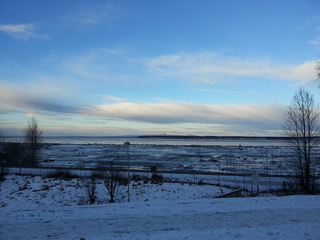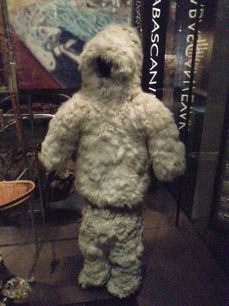Sourdough
 "It's going to be a nice day today. Almost freezing." A minute later, the speaker is fretting about climate change and the unaccustomed mildness of a winter that has 20 degree Fahrenheit temperatures in mid-December. We are in Anchorage, Alaska, where the snow shouldn't melt until spring, there are fur stores everywhere, and the films are worth freezing for.
"It's going to be a nice day today. Almost freezing." A minute later, the speaker is fretting about climate change and the unaccustomed mildness of a winter that has 20 degree Fahrenheit temperatures in mid-December. We are in Anchorage, Alaska, where the snow shouldn't melt until spring, there are fur stores everywhere, and the films are worth freezing for.
Actually, Anchorage isn't even particularly cold by Alaskan standards. You want cold, go to Fairbanks, where "20" as an answer to the current temperature means *minus* 20 Fahrenheit. And yet, this is an outdoor culture, where part of survival is embracing the cold and reveling in the sports the climate makes possible. There is a saying: "There is no such thing as bad weather - just bad gear."
The gear is expensive, but brands like Canada Goose, Mukluks, and Icebreaker come into their own here even among folks who are not rich because they're really needed. Cotton flannel, beloved New England winter wear, is more of a liability than an asset in this climate, where you want light, warm layers that keep moisture away from the body and that can be easily adapted as needed. Merino wool, silk long johns, windblocking outer layers, ear muffs, and shoes with extra room are the rule. Lacking the full range of equipment, I made do with layers of silk, merino wool, windblocking cycling pants, gaiters, slightly large Keen hiking shoes, and a borrowed Canada Goose coat - and was toasty warm on an hour-long hike through the area near Homer where Alaska: the Last Frontier is shot. (Don't be fooled by the series, folks - the locals have a real, if small, grocery store, and ready access to junk food if they want it.) So warm, in fact, that I removed my gloves and undid a few zippers. This stuff works, when correctly deployed.
Still, as all Alaskans know, you may be warm outdoors but you're not safe.  Part of the awe of visiting this state in winter is realizing that native peoples survived for thousands of years without the mod cons of high-tech fabrics, central heating, and running hot water. In the Anchorage Museum, I find a child's fur suit; the top is double-layer rabbit fur. Here, fur is politically perfectly correct.
Part of the awe of visiting this state in winter is realizing that native peoples survived for thousands of years without the mod cons of high-tech fabrics, central heating, and running hot water. In the Anchorage Museum, I find a child's fur suit; the top is double-layer rabbit fur. Here, fur is politically perfectly correct.
"We wear fur," the Anchorage innkeeper agreed. In her view, it's still the warmest option and you can see why: fur insulates animals successfully, it sheds moisture, and, perhaps most important, its functionality doesn't change when the temperatures drop below minus 40. Below that - and Fairbanks has had temperatures down to minus 60 in the last few years - many materials change their physical properties. Metal gets brittle, plastic becomes friable like potato chips. Leather, textiles, and fur continue to function. Those traditional designs hold up.
Surviving your first winter - the cold, the lack of light, is still a milestone. In Fairbanks (4F) I was told that when you make it, you're a "sourdough". Local legend has it that arriving gold miners kept their sourdough starter within their clothing to keep it warm and functional so they could have bread. Yeah: frozen yeast aren't up to much.
Alaska is facing a lot of challenges. Climate change is real to people who live next to calving glaciers (see, for example, this year's astonishing documentary of an 800-mile trek through the Alaska wilderness, ), by Bjőrn Olson. The recent drop in oil prices has been a hard blow to the state, whose predominant source of revenue is oil. It's never faced a deficit before and has no experience solving one, a challenge made even greater by the fact that the state has neither sales tax nor income tax. The present governor, Bill Walker, has called for the latter, but it's a hard sell to people more used to being paid oil dividends than paying for public services.
One issue I had never thought about is access to fresh food other than meat - fish (especially halibut), reindeer, caribou, walrus, whale. But most fresh vegetables and fruit must be imported, also dairy. Efforts are underway to improve the situation by using high tunnels, but at present, they said in Homer, 95% of the food that's bought in Alaska - though not the food that's consumed - is imported.
The reality is that Alaska is an island - an island two and a half times the size of Texas. Bounded on one side by Canada, the rest by water, it remains its own place. "When people ask if you've been 'outside' this year," my Fairbanks contact said, "they mean if you've been outside the *state*." The nice part of this is the high percentage of locally owned businesses. One of the toughest parts is that homeless people, who typically lack the identification (or the money) for air travel or entry into Canada, are trapped in one of the world's most unforgiving climates. Most people who visit go in summer, and I'm sure it's beautiful and fun, then. But winter is when you see the real place, where the light is constantly changing and the locals take pride in their ability to survive.
Wendy M. Grossman is the 2013 winner of the Enigma Award. Her Web site has an extensive archive of her books, articles, and music, and an archive of earlier columns in this series. Stories about the border wars between cyberspace and real life are posted occasionally during the week at the net.wars Pinboard - or follow on Twitter. We apologize that comments are turned off because of the high level of spambot hits on the server.